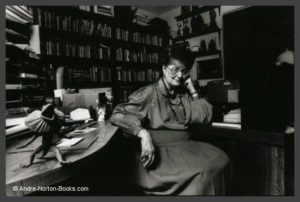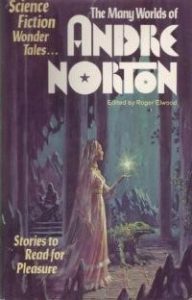Andre Norton
Born Alice Mary Norton (1912–2005), one of the most popular and prolific
writers of fantasy and science fiction for young adults—more than 130 novels over 70 years, beginning in 1934, when she legally changed her name to Andre Norton—she won
most of science fiction and fantasy’s highest awards: the Grand Master of Fantasy award, the Nebula Grand Master award, admission into the Science Fiction and Fantasy Writers’ Hall of Fame, and the World Fantasy Award for Life Achievement. The Science Fiction and Fantasy Writers of America named an award for young adult novelists for her shortly before her death.
She was born in Cleveland. After graduating from Collinwood High School and taking night classes at Western Reserve University she found work at Cleveland Public Library & as World Publishing’s sci-fi editor. Her breakthrough came in 1952 with her novel Star Man’s Son 2250 A.D. Norton’s books quickly became very popular.
Her novels have an “almost mystical sense” of romance and an “exuberant sense that the human need for life-shaping quests was innate,” wrote John Clute of the London’
newspaper The Independent. Her straightforward writing style, he said, “exposed the
sheer romantic joy of living in the galaxy-spanning civilization” that many of her works explored. In 1963, a few years after the American publication of Tolkien’s Lord of the Rings, Norton responded with a fantasy-novel series of her own. The first novel of the series, Witch World, was set on a planet that could only be reached through secret gateways. The Witch World series described a complex land called Outremer, a collection of numerous small kingdoms full of magic and conflict among dynasties entangled by romance. The series, which eventually included more than two dozen novels, made Norton famous and attracted many female readers to fantasy novels. Her other popular book series included the Beast Master and Star Ka’at novels.

Andre (née Alice) Norton understood “the human need for life-shaping quests.” (Photograph © Andre-Norton-Books.com)

“Norton’s typical protagonists,” says The Encyclopedia of Science Fiction, “have been young women or men who must undergo some form of rite de passage into a sane maturity; in so doing, they characteristically discover that the true nature of the Universe lies not in what radical transformations they might witness . . . but in its history, and in the talismans and icons associated with that history.” In the final phase of her career, beginning in the late 1960s and continuing until her death in 2005 at the age of 93, Norton produced a sequence of some 31 planetary romances begun with her successful 1963 novel Witch World that feature “complicated dynasties (and heightened emotions) depicted,” says ESF, “with considerable skill. Set centrally in the matriarchal land of Estcarp, and the neighbouring land of High Hallack, and pleasingly sensitive to feminist issues, these tales engage personable young protagonists in ‘sword and sorcery’ adventures which tend to end well.” ESF suggests an order in which it maintains these stories can most satisfyingly be read.
For more on Norton, see http://www.andre-norton-books.com/